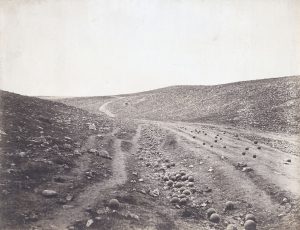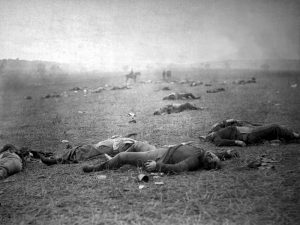Soon after the innovation of camera, exposure of war began to be documented. The Crimea war of the 1850 was the chief event that gave birth to the War lensmans like Roger Fenton, James Robertson, Felice Beato and Carol Szathmari they clicked the really first exposure of major military struggle in Crimea. The exposures that they clicked were non really barbarous in the manner modern war picture taking was portrayed, but they did bring forth a capturing certification of the expression of warfare. They failed to capture the war in its entity due to two grounds one being due to the disabilities of their camera and back their end was to demo the war in it’s the best manner possible. Picture 1 was taken by Roger Fenton called ‘The vale of shadow of death’ during the Crimea war. The image is really abstract there’s no image of war except for a waste vale which has no organic structures. Except for soiled route with scattered cannon balls.

After some old ages, Mathew Brady, Alexander Gardner and others documented the American Civil War more diagrammatically than the other lensmans who captured the Crimea war. The American civil war lensmans had to draw their bulky camera kit onto the battleground to capture the wake of war. The images that they clicked had Fieldss filled with several dead organic structures that it triggered a public esthesis. ( Picture 2 and 3 ) .
Most of their exposures of battleground were clicked after the war was over ( image 2 and 3 ) and they besides clicked images of military officers with their arms ( Picture 4 ) . They couldn’t capture the existent combat due to the restriction of equipment’s. But the historiographers say that the Civil War picture taking enabled the household to maintain exposures of their boies or hubbies as exposure of the soldiers were clicked before the conflict. The exposure besides shaped the images of political figures. President Lincoln joked that he wouldn’t be re-elected without the exposure of him taken by Mathew Brady. Civil war exposure changed the perceptual experience of people, right from the attitude towards the people who held power to the nature of warfare. During the civil wars the lensmans created three dimension images or two-channel position in order to expose life-like images. ( Picture 5 )
It is said that most of the lensman like Roger Fenton and Mathew Brady and other would frequently set up the organic structure and objects in order to make a dramatic, but altered images.
After the bulky cameras, new innovations were made for smaller and quicker camera that would snap exposures rapidly. It didn’t necessitate the lensman to draw the camera behind a dark room. This helped during the World War I, photographer could acquire nearer to the combat. The innovation of 35mm movie enlarged the intimacy of the camera ‘s oculus, allowing the World War II lensman to take part in the action. There was a alteration in position due to the innovation of Television. The war that took topographic point in Vietnam literally entered the houses of hundred thousand of Americans each dark. Today with the betterment of engineering and orbiter acquiring the intelligence of wars is far easier.
Even though there has been betterment in camera but the world of war still remains the same. The look of panic and horror revealed through the images, have accompanied wars’ from the beginning.
Peoples make determination on the footing of their interior consciousness or believes. This determination can hold positive and negative impact on the society for which the individual has to bear the effects for taking that determination. War picture taking has both positive every bit good as negative impact be it on society or on an single degree. Photographs can be used to convey out the world of war, a quotation mark by Alfred Stieglitz ( 1864-1946 ) an American lensman “In picture taking there is a world so elusive that it becomes more existent than reality” [ 1 ] . Or War Photographs can be used to gain populating out of it or for the adrenaline force per unit area that bang you through the experience of danger, a quotation mark by Robert Capa an Magyar lensman during World War 2 quoted that “I hope to remain unemployed as a war lensman till the terminal of my life” [ 2 ] . So that he wouldn’t have to be idle every bit good as Tells us that he enjoyed what he was making. Movie by Steven Silver’s ‘The Bang Bang Club’ represents the lives of four exposure journalist and who go to extreme conditions in order to snap exposures before the autumn of Apartheid in South Africa during ( 1990-1994 ) . The characters in the film besides make remarks that they didn’t want the struggle to stop rapidly as they would lose out of occupation. One can associate this film to world at that place possibly people who don’t want war but there besides exists people who earn their life out of it ( people with power, media etc. ) . War photographers’ work is non to assist people, but the presence of people who need assist provides good concern. ‘The Bang Bang Club’ besides talks about how the media can pull strings these images. Francis P. Kasoma ( 2012 ) in his article thee Foundations of African Ethics ( Afriethics ) and the Professional Practice of Journalism tells us that “in a universe in which the information expressway has made journalists pattern their profession in a haste as they strive to fulfill the universe ‘s hungering for more and quicker intelligence and other information, the humaneness of news media has progressively been giving manner to the expediences of cut-throat fiscal or political competition. [ 3 ] ” . Media does it for promotion. The authorities uses these exposures for war propaganda.
So what happens to the people who lose their life do they acquire these awards that the lensman receive for snaping their image while they are enduring, deceasing etc. ? What will be the impact on the household when they realize that their sons’ exposure has won an award for portraying his hurting?
There are some war lensmans who felt the hurting and unhappiness while snaping the exposure. One of Britain’s celebrated war lensman Don McCullin, who during his calling covered struggles across the Earth including in Vietnam, Cyprus, Iraq, Cambodia, Lebanon and Northern Ireland. He said in one of his interviews that many people want to take up a war picture taking as a calling. Doesn’t this statement make you think that there are people who want struggles to take topographic point? What about the poets like Owen and other authors like Khushwant Singh, who through their authorship have portrayed the ghastliness of war. What more it will take for the people to recognize what existent hurting is how it feels to be killed? Photos will be at that place to remind us but it merely takes some seconds for it to disappear from our memory. Don felt that by snaping their exposure he was voicing their displeasure and hurting.
But someplace down the line he stopped war picture taking and began landscape picture taking because he didn’t want to hold a repute of being among the blood and the slaughter. He was war-beaten. He had the guilt of non being able to make anything to assist the people apart from snaping exposures. He goes on to state that war is awful. We haven’t learnt anything from the yesteryear
Robert Capa’s stating “If your images are n’t good plenty, you ‘re non near plenty. [ 1 ] ” he died before acquiring excessively near a mine that killed him, while covering Indochina war. Photographers risk their lives in order to accomplish something during the war and because of that they may acquire killed in the procedure. There are some who repent subsequently and are ready for any kind of penalty they get. This is depicted really nicely in the film where Greg who receives Pulitzer Prize for capturing a minute where a adult male was being beaten up and is caught up in fire and in the film he says that he didn’t travel to salvage that adult male because he put picture taking foremost than to salvage a man’s life. But so subsequently he expresses his guilt for being shot as a penalty for all his plants. Greg besides remarks “just seeing person particularly a female parent over a immature kid or a immature combatant or a immature civilian who ‘s being killed and that look they give you as you come to snap them, while you ‘re sort of apologising about photographing” [ 4 ] .
Though these exposures captured by the lensman have the capableness to exceed clip, topographic point, moral judgement and political relations, so that they remain relevant paperss of war’s human calamity. They can keep the power to dispute long-held perceptual experiences, unlock hibernating emotions and inquiry the value of war.
But still how long will these snap aid? People outlook towards war must alter. War isn’t something that you merely relate to it with exposures it is much more than that. Photos do evoke trouble, enduring etc. but war and struggle isn’t something that people should look frontward to and media and lensmans should halt projecting war in ways to actuate people.







